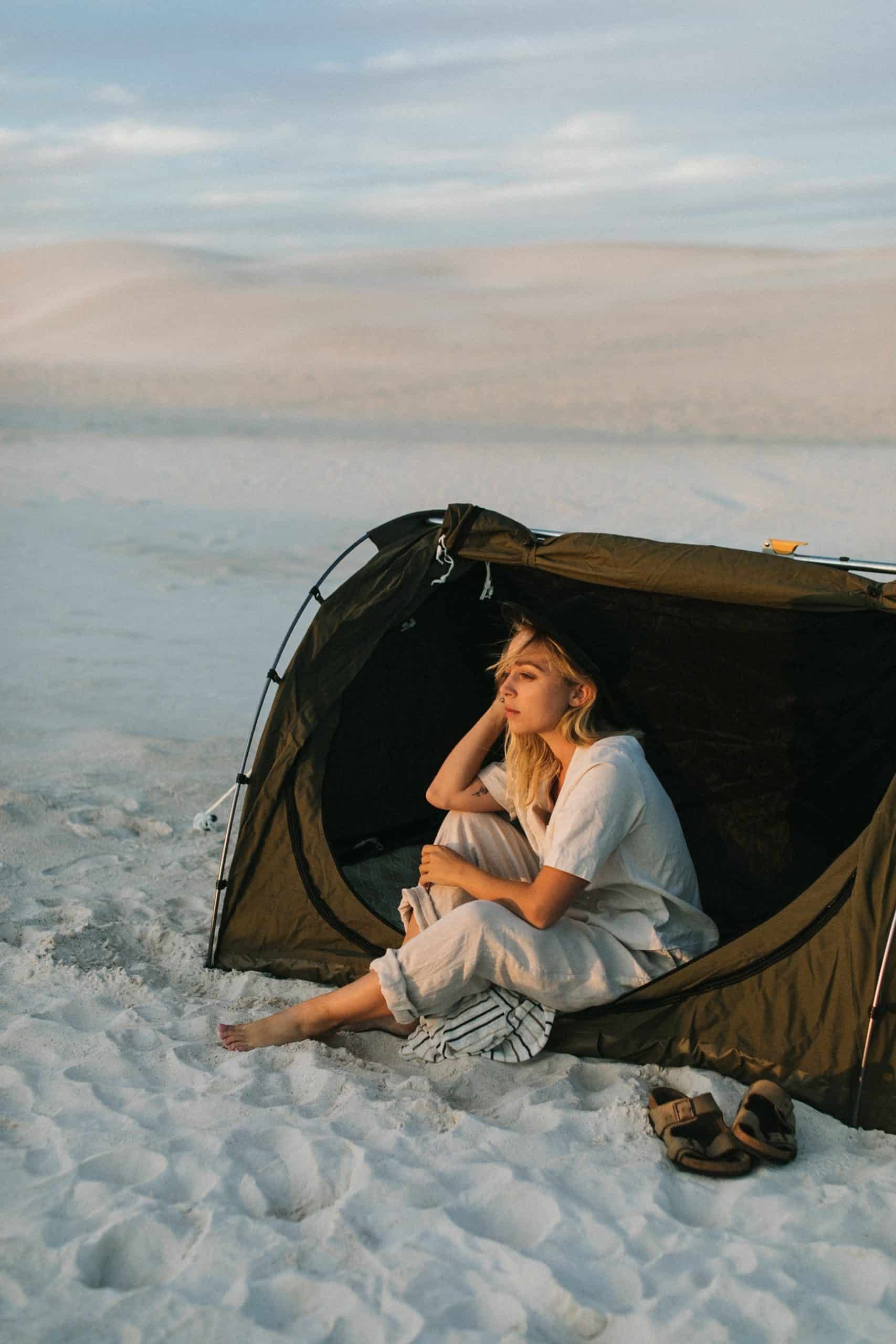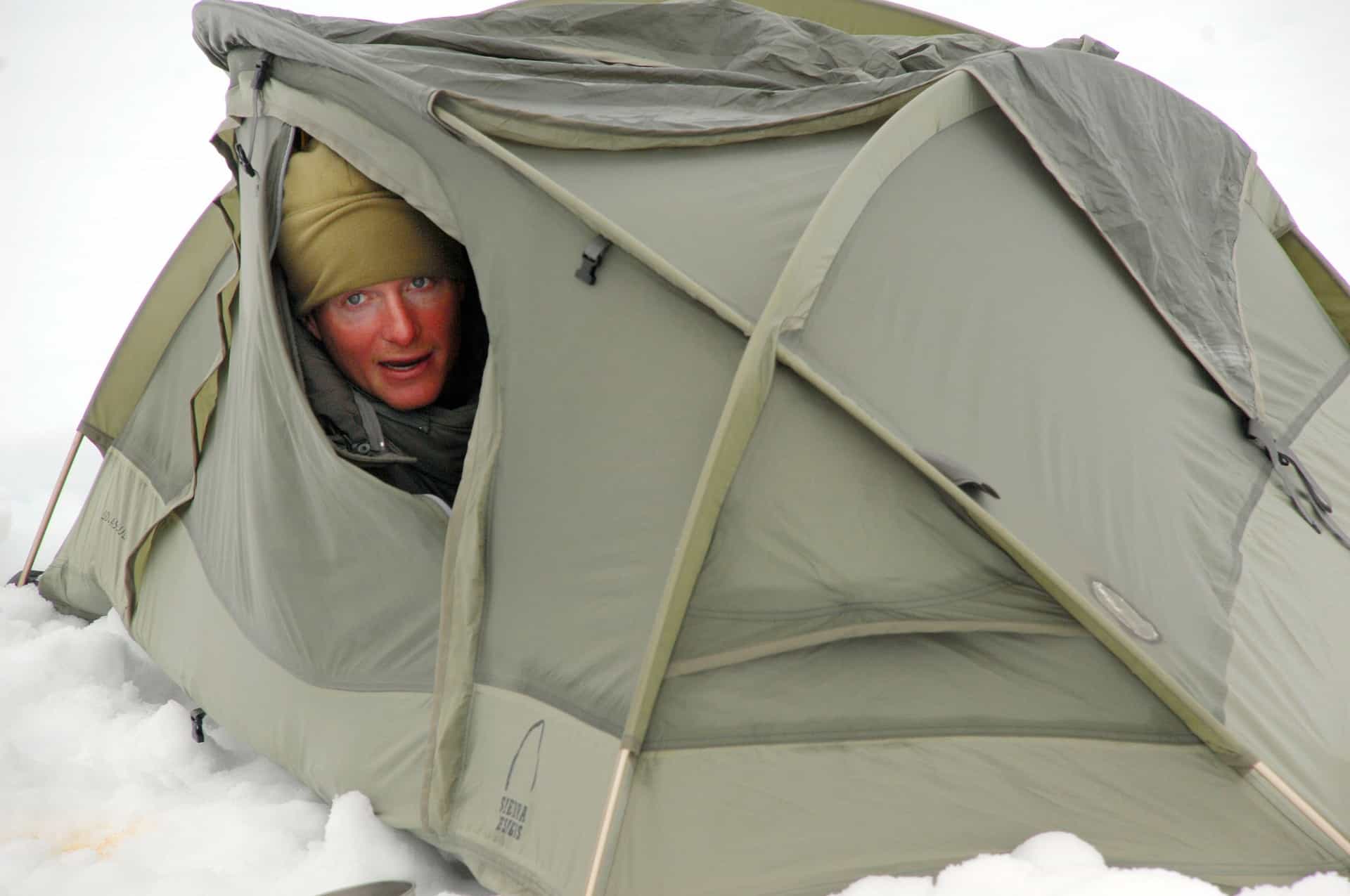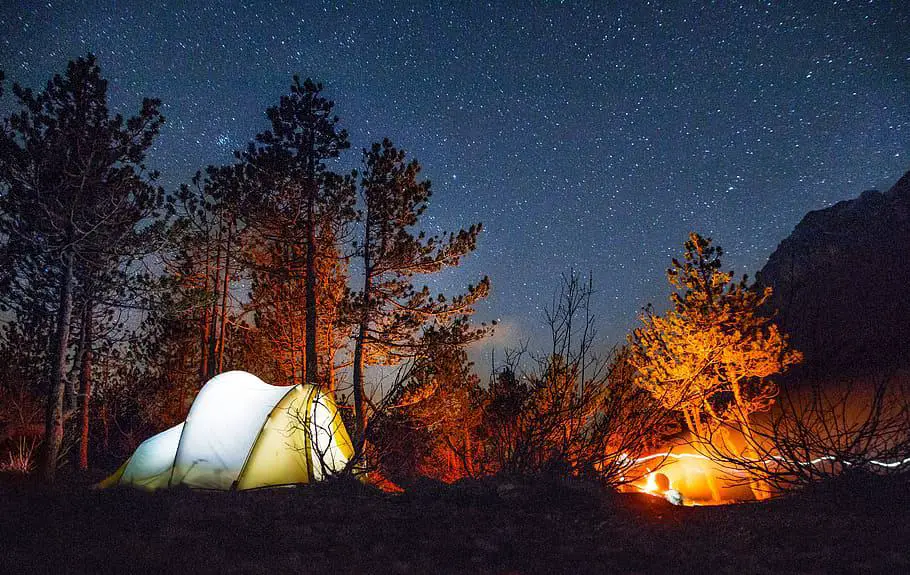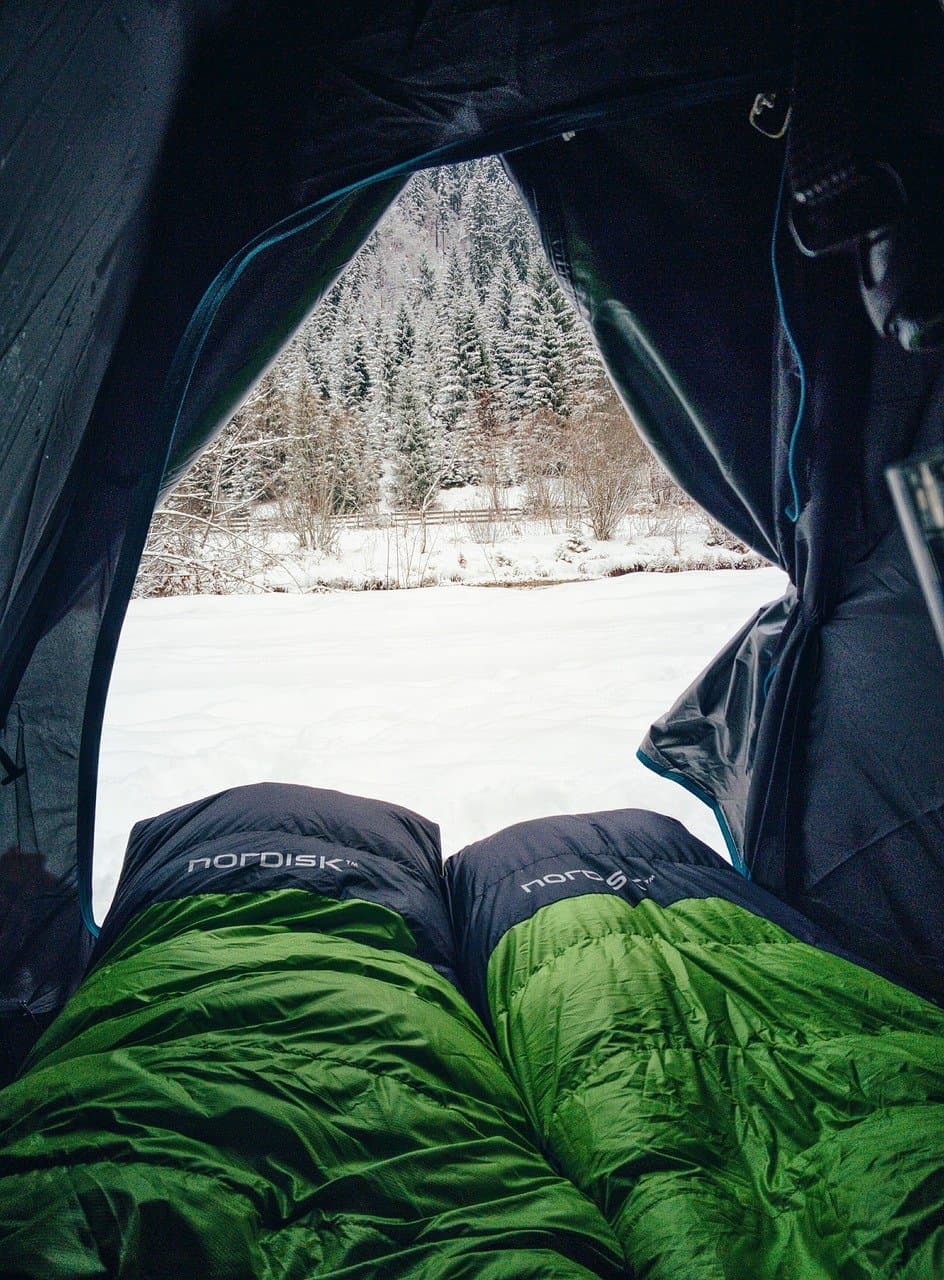How To Tent Camp In 30 Degree Weather
When people are asking how to tent camp in 30-degree weather they are usually referring to Fahrenheit which is slightly below freezing. The celsius version would be the equivalent of a hot summer day which you don’t need much to prepare for other than some cold drinks.
Not only is 30 degrees moderately cold it adds the extra challenge of keeping things like water bottles from freezing overnight. All of these hurdles can be overcome with the right equipment and skills.
You can expect to get down to these temperatures during spring and fall in most temperate climates as well as in the mountains just about any time of year. When you are in this temperature range you do run the risk of hypothermia if you don’t get things right.
From how to dress to your tent and sleep system, we will cover everything you will need to know to tent camp comfortably in 30-degree weather.
Dress for success
Staying warm in cold temperatures starts with your clothing.
Avoid cotton. It is highly absorbent which will lose you a lot of heat when it gets wet.
Dress in layers with a wicking synthetic or merino wool base layer against the skin.
Add as many insulating layers as needed for warmth.
Finish off your kit with an outer shell layer to protect from wind and water.
Limit sweating. If active, start cool so you don’t overheat and start sweating which will lead to heat loss.
Make sure you have a hat and gloves as your hands and head lose a lot of heat.
Bring a spare set of clothing so you have something dry to change into if you get wet.

Food is fuel
When camping in a tent you are the heat source so you have to make sure you have plenty of calories for your furnace. Normally it isn’t a good idea to eat a high-calorie snack before bed but when you are camping in the cold your body will turn those calories into heat rather than make you fat.
Some of my favorite options are trail mix with a lot of nuts, chocolate, and peanut butter. Fueling up is especially important if you spent the day hiking or otherwise expending energy.
When you are fatigued it is harder for your body to stay warm so make sure you replace the energy you’ve expended.
Gimme shelter
A good tent will go a long way towards keeping you warm by protecting you from wind and rain.
While you could use a 4-season tent that is designed for the cold, 30-degree weather can be managed quite well with a 3-season tent. Where you might want to choose a heavy-duty 4-season tent is when you expect to encounter a larger amount of snowfall.
A lighter tent can get crushed under the weight of snow if you get more than 12 inches overnight. This is especially a concern with the heavier wet snow that comes near the freezing point.
Tents such as the MSR Elixir or Marmot Tungsten are good options for light but sturdy tents that can handle reasonable levels of wind and snow.
If you are car camping then larger family tents can work as well but will tend to feel cooler as there is a lot more space to warm up.
With a larger tent, you can warm it with the three candle version of the UCO candle lantern. This will add warmth and light as well as help with condensation as we address below.
Whatever tent you use, make sure to have the sides of the rainfly staked out to allow for airflow on the ground level. Cool air will come in and get warmed by the occupants of the tent.
This will cause the air to rise and help create a convective current that will pull moisture out of the tent. This relies on either having vents in the roof of the tent or partly unzipping the vestibule to allow the moist air to escape.
When shopping for tents, look for models with high vents to reduce the amount of condensation buildup.
Candle in the wind
When it is cold out you will tend to get more condensation on the inside of your tent. When the vapor from your breath and body hits the inner surface of the rainfly it condenses into liquid or frost depending on how cold it is.
This can lead to getting dripping on or thinking your tent leaks.
To cut this humidity and add a slight bit of warmth to your tent consider using a UCO candle lantern. These little collapsible lanterns can hang from the inside of your tent adding some warmth and pulling out a lot of moisture.
The chain and hook place it far enough away from the tent body to not pose a fire risk. As long as your tent has ventilation there is little risk of carbon monoxide poisoning. Just be careful when removing the candle from the lantern for lighting.
Run the candle an hour before bed and an hour in the morning to help minimize the condensation in your tent.
How to get the right sleeping bag
Sleeping bag ratings aren’t explained very well, leading to a lot of people getting a bag that doesn’t keep them warm. When you see a sleeping bag that is rated for 15 Fahrenheit (-7 Celsius) don’t think it will keep you warm and toasty at that temperature.
The temperature that a sleeping bag is labeled as is the bottom limit for the average person while wearing a thermal base layer and socks.
If a sleeping bag is men’s or unisex then the rating is for men which on average is 9 Fahrenheit (5 Celcius) warmer than women.
To demystify the temperature ranges you will often see sleeping bags with an EN rating which gives three temperatures (comfort, limit, and extreme).
The first will be a rough women’s bottom limit rating, the second a men’s, and the final a temperature that the bag will keep you alive at for 6 hours without dying.
When tent camping in 30-degree whether you will want a sleeping bag that is rated for 15 degrees (-7 Celcius). This can be done with the sleeping bag alone or you can add a thermal sleeping bag liner to a summer-rated bag. Sea to Summit Reactor thermal sleeping bag liners can add up to 32 degrees to the warmth of your bag.
Don’t forget to insulate from the cold of the ground
Many people get the sleeping bag right but mess up on the insulation between them and the ground resulting in a cold night sleep they blame on the sleeping bag.
The ground is colder than you are so if you don’t get adequate insulation underneath you will lose heat all night long because the compressed material in the bottom of your sleeping bag won’t keep you warm.
The standard bed-sized air mattress isn’t insulated which will lead to the air inside eventually matching the cold of the ground. As the air cools it also loses pressure which is why they often seem like they leak overnight.
Insulated sleeping pads like you find from Thermarest or Nemo will keep you warm as well cushion you from the ground. My favorite sleeping pad is the Thermarest X-Therm which is light, warm, and comfortable.
You can also use closed-cell foam mats such as the Thermarest Zlite or yoga mats, which will provide good insulation but not as much cushion.
Choosing your campsite
Your choice of where you locate your campsite can play a role in how warm you will be. If you’ve booked a spot at a park then you might be stuck with a designated spot but if you can choose then the following tips can help use your environment to improve your comfort.
Don’t locate on low ground. Cold air sinks to the lowest point so find a spot slightly higher than the surrounding area.
Avoid ridges or open areas. High points and open areas will be more susceptible to high winds.
Find natural wind blocks. Hills, trees, or rocks can all act as wind blocks to protect your camp from exposure.
Always look around and overhead to make sure no dead trees or branches can fall on your tent.
Keep your gear from freezing
When it gets below the freezing point of water you have to not only keep yourself from freezing but you need to protect your gear from the cold.
Put at least one water bottle in the foot of your sleeping bag so you have liquid water for the morning.
Place your water filter in a freezer zip lock bag and keep it in your sleeping bag. The water in the filter can freeze and crack the membrane thus rendering it useless.
Keep any batteries close to you or in your sleeping bag. The cold will dramatically reduce battery runtime.
Tips to stay warm on a cold night
Boil water and place it in a Nalgene water bottle. Make sure the lid is tight. Place the hot bottle in a wool sock before putting it in your sleeping bag. This will warm up your sleeping bag before getting in, saving yourself a lot of energy expenditure. Once in your sleeping bag push the bottle to the foot of the bag so you have liquid water for making breakfast.
Exercise before getting in your sleeping bag. Some squats or jumping jacks will help get the blood flowing. Getting your system revved up before getting in your sleeping bag will help it warm up quicker.
Eat a high-fat/high-calorie snack and drink a hot beverage before you go to bed.
Move your sleeping pads near others in your tent to share warmth. If you have someone on each side of you and a warm sleeping pad you will find it much easier to stay warm.
Stay hydrated. When you have adequate fluid in your system it is easier for your body to move warm blood around thus spreading the heat from your core.
Conclusion
Camping in a tent when the temperatures drop below freezing is totally doable as long as you have the right gear and do the right things. New challenges are added to the mix when water can freeze but it can be a fun experience, especially when you do it for the first time.
When trying anything new in your camping journey try it close to home or the car if you can so you have the ability to get more gear or bail out if things don’t work out.






